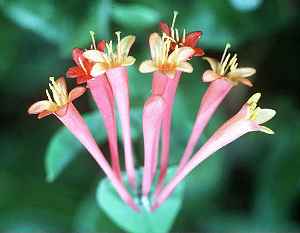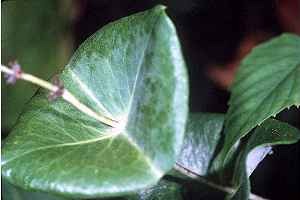Trumpet Honeysuckle
Scientific Name: Lonicera sempervirens L.
Synonym: Phenianthus sempervirens
Family: Caprifoliaceae

Britton, N.L., and A. Brown. 1913. Illustrated flora of the northern states and Canada. Vol. 3: 280.
Sunset®: 3-41
USDA: 4-10
Heat Tolerance: At least afternoon shade in Phoenix
Sun Exposure: Full sun to light shade
Origin: Eastern and southern USA
Growth Habits: twining or trailing woody semi-evergren vine, 10 to 20 feet tall (3-6 m), 3 to 6 feet spread (0.9-1.8 m); smooth leaves, 1 to 3 inches long (2.5-7 cm)
Flowers: Light orange flowers
Watering Needs: Moderate to regular water in summer
Propagation: Seeds

Robert H. Mohlenbrock. USDA SCS. 1991. Southern wetland flora: Field office guide to plant species.

Robert H. Mohlenbrock. USDA SCS. 1991. Southern wetland flora: Field office guide to plant species.
Blooming Habits:
The trumpet honeysuckle is one of the showiest vines. The tube-shaped flowers in terminal clusters, are about 2 inches long (5 cm), scarlet to orange on the outside and yellow on the inside. The flowers are a hummingbird favorite. The fruits are orange red berries, about a quarter inch in diameter. They are eaten by the birds.
Desert-Tropicals is dedicated to provide gardening advice, gardening ideas, and information about flower of all kind for landscape and collections.We try to check carefully the identification of the plants on the illustrations as well as the other information from the page, but occasionally errors do occur. if you notice anything that needs to be changed please contact us.Thanks.
© 1998-2020 Philippe Faucon, All Rights Reserved.